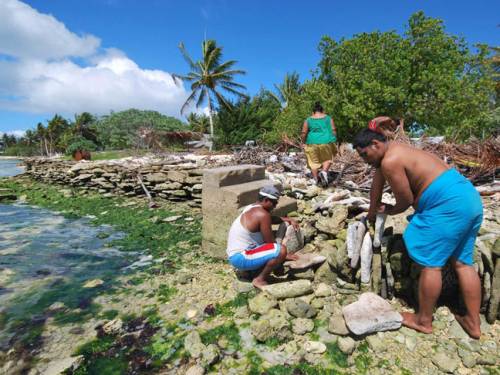Transcript from ABC, World News Australia Radio
The Australian Red Cross, together with regional scientific agencies, is launching an information campaign to help educate Pacific Island residents about the effects of climate change.
It's well known that low-lying Pacific Island nations are particularly vulnerable to extreme weather.
But research by the Australian Red Cross has found that there's limited local knowledge about how to deal with it.
To try to address this, the agency is launching a new information campaign, in conjunction with several regional scientific agencies.

The Red Cross says Pacific countries such as the Solomon Islands and Papua New Guinea are among the most vulnerable to natural disasters in the world. Photo: AAP
The Red Cross says Pacific countries such as the Solomon Islands and Papua New Guinea are among the most vulnerable to natural disasters in the world.
So the Australian Red Cross, together with Australia's CSIRO and other regional groups, has developed a series of videos and related material that aims to take the mystery out of climate science and extreme weather patterns.
It has its sights on El Niño, which can cause drier conditions and drought and La Niña, which can cause heavier rainfall, cyclones and floods.
One of the new videos uses what the Red Cross describes as a comical climate crab to make climate science more easily understandable.
(Video excerpt) "In some countries close to the equator such as Tuvalu and Nauru, La Niña can bring less rain and even drought. This can affect locally grown food sources such as taro, banana and grape fruit and sometimes lead to water shortages. In other countries like Fiji and the Solomon Islands, La Niña usually brings warmer oceans, more rain and can cause flooding. This can lead to coral bleaching, waterlogged crops and increased risk of diseases like typhoid and dengue fever. In the Solomon Islands, La Niña also brings higher sea levels."
El Niño and La Niña occur every two to three years.
But a program coordinator for the Pacific Disaster Management Partnership at the Australian Red Cross, Tom Bamforth, says weather variances are becoming more extreme.
So, he says, it's important to try to create more understanding about how to manage and adapt to these changes.
"Some of those scientific concepts if you like are not readily understood at the local level by people who are most affected by them. So the idea is to translate between scientific knowledge and local knowledge to come up with adequate ways we can prepare for those sorts of predictable events."
Senior research scientist at the Australian Bureau of Meteorology, Doctor Brad Murphy, says severe weather patterns can be particularly devastating in Pacific Island countries because the limited capacity to deal with them.
Dr Murphy says spreading the message that these weather patterns can be predicted about six months in advance might help local communities prepare.
"In Vanuatu for example the people in the region, every year they have a pretty strong wet season and then a dry season. And their cropping cycle -- when they can plant crops and harvest them -- is really closely tied in to this natural variability in the climate. And for them when this cycle is disrupted through things like El Niño which causes long droughts which means they miss out on the wet season, it has big impacts on their lives and that's a way for us to see how they understand how important the climate is in their day to day lives and their existence in the Pacific."
Research by the Red Cross Red Crescent Climate Centre found there is a lack of simple materials and educational tools about climate variations in the Pacific.
Tom Bamforth says these new videos will be distributed to humanitarian groups, schools, government departments and communities across the region.
"The people who watch the film, at the end of it, there's a practical section which promotes some more practical things that people can do and this is to do with things like water harvesting, water conservation, promotion of hygeine and sanitation. And things like in rainier periods of preparing their houses well, securing their roofs, digging water trenches if there's going to be increased rainfall. So these are quite practical things which should go toward making people more resilient to the effects of El Niño and La Niña."
Mr Bamforth says other work also needs to be done in the Pacific to ensure there is greater awareness about other weather-related events.
For example, he says, knowledge about sudden onset natural disasters like tsunamis and typhoons needs to be improved.
"We have had examples of the Pacific of people walking down to the beach when they see the sea go out thinking this is a curiosity and they're interested in this. And the consequence is they get swept away on the incoming tsunami and that happens precisely because they're not aware of the signs and their local environment so there's a lot of work to be done around those sorts of issues."
Meanwhile, the videos do, however, try to clear up some other common misconceptions.
Sorry, the comment form is closed at this time.